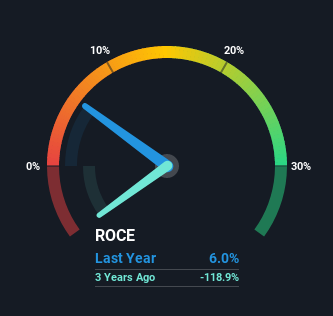- Singapore
- /
- Oil and Gas
- /
- SGX:Y35
Investors Met With Slowing Returns on Capital At AnAn International (SGX:Y35)
If we want to find a potential multi-bagger, often there are underlying trends that can provide clues. Typically, we'll want to notice a trend of growing return on capital employed (ROCE) and alongside that, an expanding base of capital employed. Basically this means that a company has profitable initiatives that it can continue to reinvest in, which is a trait of a compounding machine. However, after investigating AnAn International (SGX:Y35), we don't think it's current trends fit the mold of a multi-bagger.
Understanding Return On Capital Employed (ROCE)
If you haven't worked with ROCE before, it measures the 'return' (pre-tax profit) a company generates from capital employed in its business. The formula for this calculation on AnAn International is:
Return on Capital Employed = Earnings Before Interest and Tax (EBIT) ÷ (Total Assets - Current Liabilities)
0.06 = US$7.7m ÷ (US$465m - US$337m) (Based on the trailing twelve months to September 2021).
Therefore, AnAn International has an ROCE of 6.0%. Ultimately, that's a low return and it under-performs the Oil and Gas industry average of 16%.
See our latest analysis for AnAn International

While the past is not representative of the future, it can be helpful to know how a company has performed historically, which is why we have this chart above. If you're interested in investigating AnAn International's past further, check out this free graph of past earnings, revenue and cash flow.
The Trend Of ROCE
We've noticed that although returns on capital are flat over the last five years, the amount of capital employed in the business has fallen 35% in that same period. This indicates to us that assets are being sold and thus the business is likely shrinking, which you'll remember isn't the typical ingredients for an up-and-coming multi-bagger. Not only that, but the low returns on this capital mentioned earlier would leave most investors unimpressed.
On another note, while the change in ROCE trend might not scream for attention, it's interesting that the current liabilities have actually gone up over the last five years. This is intriguing because if current liabilities hadn't increased to 72% of total assets, this reported ROCE would probably be less than6.0% because total capital employed would be higher.The 6.0% ROCE could be even lower if current liabilities weren't 72% of total assets, because the the formula would show a larger base of total capital employed. Additionally, this high level of current liabilities isn't ideal because it means the company's suppliers (or short-term creditors) are effectively funding a large portion of the business.
The Bottom Line On AnAn International's ROCE
It's a shame to see that AnAn International is effectively shrinking in terms of its capital base. And investors may be expecting the fundamentals to get a lot worse because the stock has crashed 87% over the last five years. All in all, the inherent trends aren't typical of multi-baggers, so if that's what you're after, we think you might have more luck elsewhere.
On a final note, we found 4 warning signs for AnAn International (2 are a bit unpleasant) you should be aware of.
While AnAn International isn't earning the highest return, check out this free list of companies that are earning high returns on equity with solid balance sheets.
New: Manage All Your Stock Portfolios in One Place
We've created the ultimate portfolio companion for stock investors, and it's free.
• Connect an unlimited number of Portfolios and see your total in one currency
• Be alerted to new Warning Signs or Risks via email or mobile
• Track the Fair Value of your stocks
Have feedback on this article? Concerned about the content? Get in touch with us directly. Alternatively, email editorial-team (at) simplywallst.com.
This article by Simply Wall St is general in nature. We provide commentary based on historical data and analyst forecasts only using an unbiased methodology and our articles are not intended to be financial advice. It does not constitute a recommendation to buy or sell any stock, and does not take account of your objectives, or your financial situation. We aim to bring you long-term focused analysis driven by fundamental data. Note that our analysis may not factor in the latest price-sensitive company announcements or qualitative material. Simply Wall St has no position in any stocks mentioned.
About SGX:Y35
AnAn International
An investment holding company, trades in petrochemical, fuel oil, and petroleum products in Europe, Singapore, Hong Kong, and the People’s Republic of China.
Solid track record with excellent balance sheet.
Market Insights
Community Narratives





